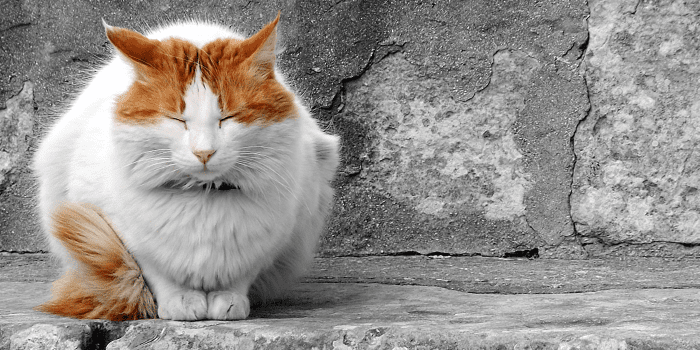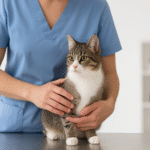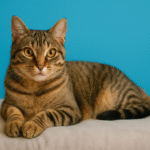Most well-cared-for pet cats can live to age 14 or 15, with some occasionally reaching 20. Life expectancy is increasing due to advances in disease prevention, a better understanding of diet, improved drugs and treatments, and more cats being kept indoors away from traffic hazards.
Senior Years
By about age 10, your cat may begin to show signs of aging: weight loss (or gain), deteriorating eyesight, dental disease, a decrease in mobility, less fastidious grooming, and a thinner, less shiny coat.
His personality may change, too, with your cat becoming easily irritated and noisier, especially at night. As a senior, he may occasionally feel disorientated and relieve himself outside the litter box.
The older cat will need more frequent health checks. You may want to start increasing his routine visits to the vet to twice a year. Many veterinary practices now offer clinics for older cats, to detect and deal with age-related problems.
There are many treatments now available to help manage chronic conditions—even senility.
Home Care
You may need to make adaptations to your cat’s diet and living conditions to maximize his comfort and well-being as he ages. Your vet may recommend a “senior” diet, which will supply the correct nutrients for the changes in your cat’s metabolism and digestive processes.
Your cat may prefer to eat smaller meals more often during the day. If he seems less interested in eating, try warmer or tastier foods to tempt him. It is also helpful to weigh your cat every two weeks; older cats can gain excess weight due to inactivity, or lose weight due to difficulty with eating or conditions such as hyperthyroidism, a common hormonal disorder in seniors.
As your cat’s body becomes less supple, he may need help with grooming hard-to-reach places. Gentle brushing a few times a week will keep him clean and make him more comfortable. His claws can grow harder with age and become overgrown if he is not very active, so clip them regularly or ask your vet to do it for you.
If your cat is not as agile as he used to be, make sure he doesn’t have to jump up to reach his food and water bowls. Keep bowls and litter boxes on each floor of the house, in quiet places where he won’t be disturbed. Use boxes or furniture to make “stepping- stones,” so that he can still reach his favorite perches or windowsills.
Have several warm, comfortable cat beds around your home, in places where your cat already enjoys sleeping, so that he does not have to go far to find a cozy corner. If your cat is having trouble with soiling, use washable beds or cardboard boxes lined with newspaper that can be thrown away.
Even if your cat still prefers to urinate and defecate outdoors, it is wise to have litter boxes in the house. Older cats are often less willing to go outdoors, either because they want to avoid confrontation with other cats or because they no longer have the urge to hunt and explore.
Even an old cat still likes to have fun, so provide him with toys. Playing with your cat helps to keep his mind active and lets him express his natural instincts, although you will have to play more gently than before.
Warning Signs
You need to keep a closer eye on an older cat to detect any alterations in his normal habits. In particular, let your vet know if you notice any of the following changes.
Watch for any increase in appetite, with your cat seeming ravenously hungry but losing weight even with regular meals.
In contrast, if your cat is obviously hungry but turns away from certain foods (especially hard foods), or paws at his mouth, he may have problems with loose or painful teeth or difficulty swallowing.
Increased thirst may cause your cat to use the litter box more than usual and to start drinking from odd places such as ponds and bathroom faucets. An elderly cat may also become dehydrated.
Check by grasping the scruff of the neck and letting go. The skin should fall back instantly; if it does not, the cat may not be getting enough liquid. Alert your vet promptly if your cat is straining or crying when he passes feces or urine, or if he starts having “accidents” in the home. He may need investigations for bowel or bladder disorders.
Many older cats develop stiff joints or arthritis that cause difficulty with running and jumping, and your cat may struggle to climb stairs. Elderly cats may also lose vision, causing them to bump into things or misjudge heights.
A cat that is feeling very sick or showing signs of dementia may become more withdrawn or aggressive, hide away, or meow more than usual.
Euthanasia
For a very old or sick cat, sometimes the kindest thing to do is to give him a dignified, peaceful ending. Euthanasia is usually carried out in a veterinary practice, but it can be done at home (you will need to book in advance).
The vet will give an injection of anesthetic—in effect, an overdose—into a front leg vein. The procedure is painless and the cat will become unconscious before passing away. There may be involuntary movements, and the bladder or bowels may empty.
You can ask for your cat to be cremated, or take the body home. Many owners wish to bury their pet in the yard, perhaps in one of his favorite places, while others opt for burial in a pet cemetery.




